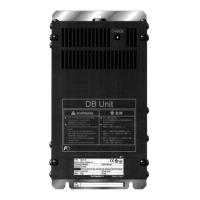Input phase loss
Phenomena Input phase loss occurred, or interphase voltage unbalance rate was large.
If the auxiliary power (R0, T0) is taken from the breaker primary side (power supply side), a “
lin
”
alarm may occur even if there has been no phase loss.
Possible Causes Check and Measures
(1) Breaks in wiring to the main
power input terminals.
Measure the input voltage.
Repair or replace the main circuit power input wires or input devices
(MCCB, MC, etc.).
(2) The screws on the main power
input terminals are loosely
tightened.
Check if the screws on the main power input terminals have become
loose.
Tighten the terminal screws to the recommended torque.
(3) Interphase voltage unbalance
among three phases was too
large.
Measure the input voltage.
Connect an AC reactor (ACR) to lower the voltage unbalance
between input phases.
Increase the inverter capacity.
(4) Overload cyclically occurred. Measure the ripple wave of the DC intermediate circuit voltage.
If the ripple is large, increase the inverter capacity.
(5) Single-phase voltage was input
to the three-phase input
inverter.
Check the inverter type.
Apply three-phase power.
Undervoltage
Phenomena DC intermediate circuit voltage has dropped below the undervoltage detection level.
Possible Causes Check and Measures
(1) A momentary power failure
occurred.
[Subcode:1]
[Subcode:
3]
Release the alarm.
If you want to restart running the motor without treating this
condition as an alarm, set F14 to “3,” “4,” or “5,” depending on the
load type.
(2) The power to the inverter was
switched back to ON too soon
(when F14 = 1).
[Subcode:2]
Check if the power to the inverter was switched back to ON while the
control power was still alive. Check whether the LEDs on the keypad are
lit.
Turn the power ON again after all LEDs on the keypad go off.
(3) The power supply voltage did
not reach the inverter's type
correct range.
Measure the input voltage.
Increase the voltage to within the specified range.
(4) Peripheral equipment for the
power circuit malfunctioned, or
the connection was incorrect.
Measure the input voltage to find which peripheral equipment
malfunctioned or which connection is incorrect.
Replace any faulty peripheral equipment, or correct any incorrect
connections.
(5) Any other loads connected to
the same power supply has
required a large starting current,
causing a temporary voltage
drop.
Measure the input voltage and check the voltage fluctuation.
Reconsider the power supply system configuration.
(6) Inverter's inrush current caused
the power voltage drop because
the power supply transformer
capacity was insufficient.
Check if the alarm occurs when a molded case circuit breaker (MCCB),
earth leakage circuit breaker (ELCB) (with overcurrent protection) or
magnetic contactor (MC) is turned ON.
Reconsider the capacity of the power supply transformer.

